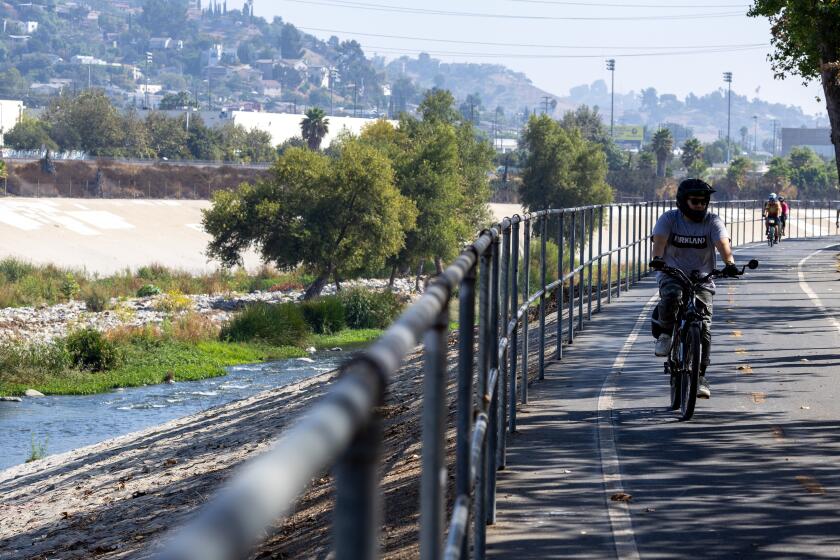Newton: The LAPD’s overtime issue
The struggle to expand the Los Angeles Police Department to 10,000 officers has occupied three mayors over two decades. Mayor Antonio Villaraigosa has brought the department right to the verge of that benchmark — the force today numbers 9,824 — but an important budgeting decision a few years back has quietly whittled away at the achievement, undermining some of the LAPD’s crime-fighting efforts and creating a growing long-term liability for the city that will hamstring the mayor’s successor.
In 2009, as part of balancing that year’s budget, Villaraigosa ordered the LAPD to stop paying overtime. That saved the city almost $80 million a year, but not without consequence.
It would be one thing if a police department could be run without asking officers to work beyond their normal days. But that’s not feasible, as Chief Charlie Beck told me last week. Officers responding to a call for help cannot simply head for home because their shifts are up; detectives can’t refuse to testify just because it’s their day off; SWAT officers can’t depend on barricaded suspects to give up at the end of an eight-hour day. Historically, officers worked that extra time and then were paid for it. Now, they work the time anyway but are forced either to bank the pay for later or take compensatory time off.
After the department lost its overtime budget, Deputy Chief Rick Jacobs, Beck’s chief of staff, said authorities were forced to trim some specialized units. Some detectives were returned to patrol and some officers were taken out of “crime suppression units” — groups of officers deployed to a particular problem area to knock down a crime problem.
Even with all that, however, the LAPD’s loss of an overtime budget meant that on any given day, the patrol force was likely to be about 600 officers short of what it would have been with overtime fully funded. That’s the equivalent of each LAPD station losing about 30 officers.
The department got a bit of relief when the city renegotiated its contract with the police union in 2011. In that contract, officers were allowed to bank as much as 800 hours of overtime, so rather than take time off, they could accrue huge sums of owed time, to be cashed in when they retire. That helped increase the force’s street presence, but even today, the department is short about 450 officers as a result of officers taking comp time rather than being paid overtime.
Meanwhile, the department is accruing debt to officers who bank their time. As of mid-2009, the department’s accumulated debt to its officers for unused overtime was about $43 million; after three years, that number now is more than $100 million. In one sense, that’s a triumph of management, since the department once spent nearly $80 million a year on overtime. But it’s pushing the cost into the future and is more expensive than simply paying as it goes, since officers who cash in their overtime at retirement are paid 90 minutes for each hour of overtime work, and the rate is calculated at an officer’s final salary instead of the salary at the time the overtime was earned.
Moreover, this is about safety, not just money. Skeptics have questioned whether increasing the size of police forces is the most effective path to safer cities. And certainly what makes crime rise or fall isn’t a simple equation of more officers automatically equals less crime. But research has made it increasingly clear that police presence matters. Higher police-to-citizen ratios, combined with smarter policing, can dramatically lower crime.
And Los Angeles history certainly supports that conclusion: When Richard Riordan came to office in 1993, the LAPD had about 7,500 officers and more than 1,000 murders a year. Riordan added thousands of officers, and by the time Villaraigosa became mayor, the annual number of murders had dropped to about 500. Villaraigosa continued to push hiring, and last year, fewer than 300 city residents died as a result of homicides. Overall, violence during Villaraigosa’s tenure has fallen from 42,000 violent crimes in 2004 to 20,000 last year.
Not all of that can be attributed to a larger force, since crime has dropped in cities across the country. But most of those who’ve studied L.A.’s experience have concluded that the steep crime decline wouldn’t have been possible without a larger police force, in part because it has permitted the LAPD to employ smarter, more officer-intensive strategies for fighting crime.
Barring an awful December, crime will decline yet again this year, Beck said, if only by a relatively modest 1.5%. With an additional 500 officers at his disposal, he says, the drop would have been greater and the public safer. And Beck isn’t alone in worrying that, if hiring is halted next year — and overtime remains off-limits — crime could start to rise again.
More to Read
A cure for the common opinion
Get thought-provoking perspectives with our weekly newsletter.
You may occasionally receive promotional content from the Los Angeles Times.











